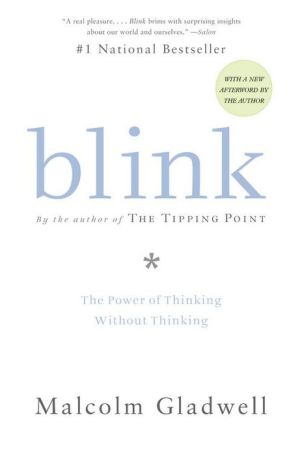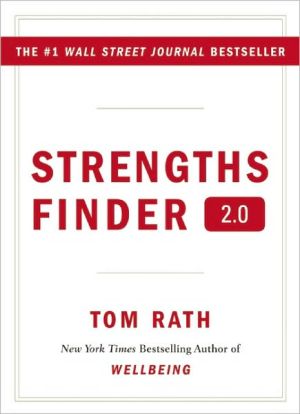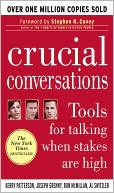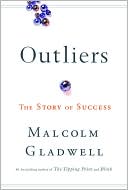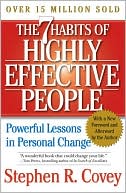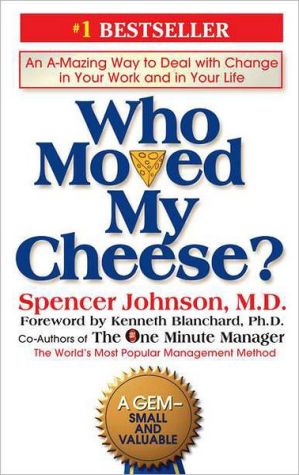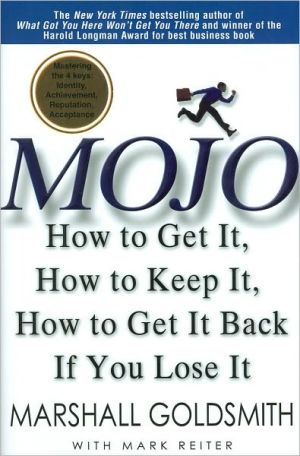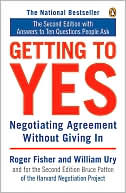Blink: The Power of Thinking without Thinking
In his landmark bestseller The Tipping Point, Malcolm Gladwell redefined how we understand the world around us. Now, in Blink, he revolutionizes the way we understand the world within. Blink is a book about how we think without thinking, about choices that seem to be made in an instant-in the blink of an eye-that actually aren't as simple as they seem. Why are some people brilliant decision makers, while others are consistently inept? Why do some people follow their instincts and win, while...
Search in google:
In this best-seller, a staff writer for The New Yorker weighs the factors that determine good decision-making. Drawing on recent cognitive research, Gladwell concludes that those who quickly filter out extraneous information generally make better decisions than those who discount their first impressions. The author of The Tipping Point (2000) cites the implications for such areas as emergency situations and marketing, plus some notable exceptions. Annotation ©2005 Book News, Inc., Portland, OR The Washington Post - Howard Gardner In Blink, Malcolm Gladwell, a former science and business reporter at The Washington Post who now writes for the New Yorker, offers his account of this sort of seemingly instantaneous judgment. Readers acquainted with Gladwell's articles and his 2000 bestseller The Tipping Point will have high anticipations for this volume; those expectations will be met. The book features the fascinating case studies, skilled interweavings of psychological experiments and explanations and unexpected connections among disparate phenomenon that are Gladwell's impressive trademark.
Blink\ The Power of Thinking Without Thinking \ \ By Malcolm Gladwell \ Little, Brown\ Copyright © 2005 Malcolm Gladwell\ All right reserved.\ ISBN: 0-316-17232-4 \ \ \ Chapter One\ The Theory of Thin Slices: How a Little Bit of Knowledge Goes a Long Way \ Some years ago, a young couple came to the University of Washington to visit the laboratory of a psychologist named John Gottman. They were in their twenties, blond and blue-eyed with stylishly tousled haircuts and funky glasses. Later, some of the people who worked in the lab would say they were the kind of couple that is easy to like-intelligent and attractive and funny in a droll, ironic kind of way-and that much is immediately obvious from the videotape Gottman made of their visit. The husband, whom I'll call Bill, had an endearingly playful manner. His wife, Susan, had a sharp, deadpan wit.\ They were led into a small room on the second floor of the nondescript two-story building that housed Gottman's operations, and they sat down about five feet apart on two office chairs mounted on raised platforms. They both had electrodes and sensors clipped to their fingers and ears, which measured things like their heart rate, how much they were sweating, and the temperature of their skin. Under their chairs, a "jiggle-o-meter" on the platform measured how much each of them moved around. Two video cameras, one aimed at each person, recordedeverything they said and did. For fifteen minutes, they were left alone with the cameras rolling, with instructions to discuss any topic from their marriage that had become a point of contention. For Bill and Sue it was their dog. They lived in a small apartment and had just gotten a very large puppy. Bill didn't like the dog; Sue did. For fifteen minutes, they discussed what they ought to do about it.\ The videotape of Bill and Sue's discussion seems, at least at first, to be a random sample of a very ordinary kind of conversation that couples have all the time. No one gets angry. There are no scenes, no breakdowns, no epiphanies. "I'm just not a dog person" is how Bill starts things off, in a perfectly reasonable tone of voice. He complains a little bit-but about the dog, not about Susan. She complains, too, but there are also moments when they simply forget that they are supposed to be arguing. When the subject of whether the dog smells comes up, for example, Bill and Sue banter back and forth happily, both with a half smile on their lips.\ Sue: Sweetie! She's not smelly ...\ Bill: Did you smell her today?\ Sue: I smelled her. She smelled good. I petted her, and my hands didn't stink or feel oily. Your hands have never smelled oily.\ Bill: Yes, sir.\ Sue: I've never let my dog get oily.\ Bill: Yes, sir. She's a dog.\ Sue: My dog has never gotten oily. You'd better be careful.\ Bill: No, you'd better be careful.\ Sue: No, you'd better be careful.... Don't call my dog oily, boy.\ 1. The Love Lab\ How much do you think can be learned about Sue and Bill's marriage by watching that fifteen-minute videotape? Can we tell if their relationship is healthy or unhealthy? I suspect that most of us would say that Bill and Sue's dog talk doesn't tell us much. It's much too short. Marriages are buffeted by more important things, like money and sex and children and jobs and in-laws, in constantly changing combinations. Sometimes couples are very happy together. Some days they fight. Sometimes they feel as though they could almost kill each other, but then they go on vacation and come back sounding like newlyweds. In order to "know" a couple, we feel as though we have to observe them over many weeks and months and see them in every state-happy, tired, angry, irritated, delighted, having a nervous breakdown, and so on-and not just in the relaxed and chatty mode that Bill and Sue seemed to be in. To make an accurate prediction about something as serious as the future of a marriage-indeed, to make a prediction of any sort-it seems that we would have to gather a lot of information and in as many different contexts as possible.\ But John Gottman has proven that we don't have to do that at all. Since the 1980s, Gottman has brought more than three thousand married couples-just like Bill and Sue-into that small room in his "love lab" near the University of Washington campus. Each couple has been videotaped, and the results have been analyzed according to something Gottman dubbed SPAFF (for specific affect), a coding system that has twenty separate categories corresponding to every conceivable emotion that a married couple might express during a conversation. Disgust, for example, is 1, contempt is 2, anger is 7, defensiveness is 10, whining is 11, sadness is 12, stonewalling is 13, neutral is 14, and so on. Gottman has taught his staff how to read every emotional nuance in people's facial expressions and how to interpret seemingly ambiguous bits of dialogue. When they watch a marriage videotape, they assign a SPAFF code to every second of the couple's interaction, so that a fifteen-minute conflict discussion ends up being translated into a row of eighteen hundred numbers-nine hundred for the husband and nine hundred for the wife. The notation "7, 7, 14, 10, 11, 11," for instance, means that in one six-second stretch, one member of the couple was briefly angry, then neutral, had a moment of defensiveness, and then began whining. Then the data from the electrodes and sensors is factored in, so that the coders know, for example, when the husband's or the wife's heart was pounding or when his or her temperature was rising or when either of them was jiggling in his or her seat, and all of that information is fed into a complex equation.\ On the basis of those calculations, Gottman has proven something remarkable. If he analyzes an hour of a husband and wife talking, he can predict with 95 percent accuracy whether that couple will still be married fifteen years later. If he watches a couple for fifteen minutes, his success rate is around 90 percent. Recently, a professor who works with Gottman named Sybil Carrère, who was playing around with some of the videotapes, trying to design a new study, discovered that if they looked at only three minutes of a couple talking, they could still predict with fairly impressive accuracy who was going to get divorced and who was going to make it. The truth of a marriage can be understood in a much shorter time than anyone ever imagined.\ John Gottman is a middle-aged man with owl-like eyes, silvery hair, and a neatly trimmed beard. He is short and very charming, and when he talks about something that excites him-which is nearly all the time-his eyes light up and open even wider. During the Vietnam War, he was a conscientious objector, and there is still something of the '60s hippie about him, like the Mao cap he sometimes wears over his braided yarmulke. He is a psychologist by training, but he also studied mathematics at MIT, and the rigor and precision of mathematics clearly moves him as much as anything else. When I met Gottman, he had just published his most ambitious book, a dense five-hundred-page treatise called The Mathematics of Divorce, and he attempted to give me a sense of his argument, scribbling equations and impromptu graphs on a paper napkin until my head began to swim.\ Gottman may seem to be an odd example in a book about the thoughts and decisions that bubble up from our unconscious. There's nothing instinctive about his approach. He's not making snap judgments. He's sitting down with his computer and painstakingly analyzing videotapes, second by second. His work is a classic example of conscious and deliberate thinking. But Gottman, it turns out, can teach us a great deal about a critical part of rapid cognition known as thin-slicing. "Thin-slicing" refers to the ability of our unconscious to find patterns in situations and behavior based on very narrow slices of experience. When Evelyn Harrison looked at the kouros and blurted out, "I'm sorry to hear that," she was thin-slicing; so were the Iowa gamblers when they had a stress reaction to the red decks after just ten cards.\ Thin-slicing is part of what makes the unconscious so dazzling. But it's also what we find most problematic about rapid cognition. How is it possible to gather the necessary information for a sophisticated judgment in such a short time? The answer is that when our unconscious engages in thin-slicing, what we are doing is an automated, accelerated unconscious version of what Gottman does with his videotapes and equations. Can a marriage really be understood in one sitting? Yes it can, and so can lots of other seemingly complex situations. What Gottman has done is to show us how.\ 2. Marriage and Morse Code\ I watched the videotape of Bill and Sue with Amber Tabares, a graduate student in Gottman's lab who is a trained SPAFF coder. We sat in the same room that Bill and Sue used, watching their interaction on a monitor. The conversation began with Bill. He liked their old dog, he said. He just didn't like their new dog. He didn't speak angrily or with any hostility. It seemed like he genuinely just wanted to explain his feelings.\ If we listened closely, Tabares pointed out, it was clear that Bill was being very defensive. In the language of SPAFF, he was cross-complaining and engaging in "yes-but" tactics-appearing to agree but then taking it back. Bill was coded as defensive, as it turned out, for forty of the first sixty-six seconds of their conversation. As for Sue, while Bill was talking, on more than one occasion she rolled her eyes very quickly, which is a classic sign of contempt. Bill then began to talk about his objection to the pen where the dog lives. Sue replied by closing her eyes and then assuming a patronizing lecturing voice. Bill went on to say that he didn't want a fence in the living room. Sue said, "I don't want to argue about that," and rolled her eyes-another indication of contempt. "Look at that," Tabares said. "More contempt. We've barely started and we've seen him be defensive for almost the whole time, and she has rolled her eyes several times."\ At no time as the conversation continued did either of them show any overt signs of hostility. Only subtle things popped up for a second or two, prompting Tabares to stop the tape and point them out. Some couples, when they fight, fight. But these two were a lot less obvious. Bill complained that the dog cut into their social life, since they always had to come home early for fear of what the dog might do to their apartment. Sue responded that that wasn't true, arguing, "If she's going to chew anything, she's going to do it in the first fifteen minutes that we're gone." Bill seemed to agree with that. He nodded lightly and said, "Yeah, I know," and then added, "I'm not saying it's rational. I just don't want to have a dog."\ Tabares pointed at the videotape. "He started out with 'Yeah, I know.' But it's a yes-but. Even though he started to validate her, he went on to say that he didn't like the dog. He's really being defensive. I kept thinking, He's so nice. He's doing all this validation. But then I realized he was doing the yes-but. It's easy to be fooled by them."\ Bill went on: "I'm getting way better. You've got to admit it. I'm better this week than last week, and the week before and the week before."\ Tabares jumped in again. "In one study, we were watching newlyweds, and what often happened with the couples who ended up in divorce is that when one partner would ask for credit, the other spouse wouldn't give it. And with the happier couples, the spouse would hear it and say, 'You're right.' That stood out. When you nod and say 'uh-huh' or 'yeah,' you are doing that as a sign of support, and here she never does it, not once in the entire session, which none of us had realized until we did the coding.\ "It's weird," she went on. "You don't get the sense that they are an unhappy couple when they come in. And when they were finished, they were instructed to watch their own discussion, and they thought the whole thing was hilarious. They seem fine, in a way. But I don't know. They haven't been married that long. They're still in the glowy phase. But the fact is that she's completely inflexible. They are arguing about dogs, but it's really about how whenever they have a disagreement, she's completely inflexible. It's one of those things that could cause a lot of long-term harm. I wonder if they'll hit the seven-year wall. Is there enough positive emotion there? Because what seems positive isn't actually positive at all."\ What was Tabares looking for in the couple? On a technical level, she was measuring the amount of positive and negative emotion, because one of Gottman's findings is that for a marriage to survive, the ratio of positive to negative emotion in a given encounter has to be at least five to one. On a simpler level, though, what Tabares was looking for in that short discussion was a pattern in Bill and Sue's marriage, because a central argument in Gottman's work is that all marriages have a distinctive pattern, a kind of marital DNA, that surfaces in any kind of meaningful interaction. This is why Gottman asks couples to tell the story of how they met, because he has found that when a husband and wife recount the most important episode in their relationship, that pattern shows up right away.\ "It's so easy to tell," Gottman says. "I just looked at this tape yesterday. The woman says, 'We met at a ski weekend, and he was there with a bunch of his friends, and I kind of liked him and we made a date to be together. But then he drank too much, and he went home and went to sleep, and I was waiting for him for three hours. I woke him up, and I said I don't appreciate being treated this way. You're really not a nice person. And he said, yeah, hey, I really had a lot to drink.'" There was a troubling pattern in their first interaction, and the sad truth was that that pattern persisted throughout their relationship. "It's not that hard," Gottman went on. "When I first started doing these interviews, I thought maybe we were getting these people on a crappy day. But the prediction levels are just so high, and if you do it again, you get the same pattern over and over again."\ One way to understand what Gottman is saying about marriages is to use the analogy of what people in the world of Morse code call a fist. Morse code is made up of dots and dashes, each of which has its own prescribed length. But no one ever replicates those prescribed lengths perfectly. When operators send a message-particularly using the old manual machines known as the straight key or the bug-they vary the spacing or stretch out the dots and dashes or combine dots and dashes and spaces in a particular rhythm. Morse code is like speech. Everyone has a different voice.\ In the Second World War, the British assembled thousands of so-called interceptors-mostly women-whose job it was to tune in every day and night to the radio broadcasts of the various divisions of the German military.\ \ Continues...\ \ \ \ Excerpted from Blink by Malcolm Gladwell Copyright © 2005 by Malcolm Gladwell. Excerpted by permission.\ All rights reserved. No part of this excerpt may be reproduced or reprinted without permission in writing from the publisher.\ Excerpts are provided by Dial-A-Book Inc. solely for the personal use of visitors to this web site. \ \
Introduction : the statue that didn't look right31The theory of thin slices : how a little bit of knowledge goes a long way182The locked door : the secret life of snap decisions483The Warren Harding error : why we fall for tall, dark, and handsome men724Paul Van Riper's big victory : creating structure for spontaneity995Kenna's dilemma : the right - and wrong - way to ask people what they want1476Seven seconds in the Bronx : the delicate art of mind reading189Conclusion : listening with your eyes : the lessons of blink245
\ From Barnes & NobleRash, impetuous, hasty, careless -- snap judgments conjure up a troubling list of negatives. But Tipping Point author Malcolm Gladwell, aware that the flip side of a snap judgment is a brilliant intuitive act, set out to discover what underlies our gut decisions, exploring when we can (and should) trust them…even whether we can learn to make good ones. From recognizing a brilliant French horn soloist to avoiding another Amadou Diallo shooting, he offers surprising insights into the power of the unconscious to get it right.\ \ \ \ \ Howard GardnerIn Blink, Malcolm Gladwell, a former science and business reporter at The Washington Post who now writes for the New Yorker, offers his account of this sort of seemingly instantaneous judgment. Readers acquainted with Gladwell's articles and his 2000 bestseller The Tipping Point will have high anticipations for this volume; those expectations will be met. The book features the fascinating case studies, skilled interweavings of psychological experiments and explanations and unexpected connections among disparate phenomenon that are Gladwell's impressive trademark.\ — The Washington Post\ \ \ Publishers WeeklyBest-selling author Gladwell (The Tipping Point) has a dazzling ability to find commonality in disparate fields of study. As he displays again in this entertaining and illuminating look at how we make snap judgments-about people's intentions, the authenticity of a work of art, even military strategy-he can parse for general readers the intricacies of fascinating but little-known fields like professional food tasting (why does Coke taste different from Pepsi?). Gladwell's conclusion, after studying how people make instant decisions in a wide range of fields from psychology to police work, is that we can make better instant judgments by training our mind and senses to focus on the most relevant facts-and that less input (as long as it's the right input) is better than more. Perhaps the most stunning example he gives of this counterintuitive truth is the most expensive war game ever conducted by the Pentagon, in which a wily marine officer, playing "a rogue military commander" in the Persian Gulf and unencumbered by hierarchy, bureaucracy and too much technology, humiliated American forces whose chiefs were bogged down in matrixes, systems for decision making and information overload. But if one sets aside Gladwell's dazzle, some questions and apparent inconsistencies emerge. If doctors are given an algorithm, or formula, in which only four facts are needed to determine if a patient is having a heart attack, is that really educating the doctor's decision-making ability-or is it taking the decision out of the doctor's hands altogether and handing it over to the algorithm? Still, each case study is satisfying, and Gladwell imparts his own evident pleasure in delving into a wide range of fields and seeking an underlying truth. Agent, Tina Bennett. (Jan. 13) Forecast: A 25-city tour (including several university towns) should introduce Gladwell to new readers and help sell out the 200,000-copy first printing. Copyright 2004 Reed Business Information.\ \ \ \ \ Howard GardnerIn Blink, Malcolm Gladwell, a former science and business reporter at The Washington Post who now writes for the New Yorker, offers his account of this sort of seemingly instantaneous judgment. Readers acquainted with Gladwell's articles and his 2000 bestseller The Tipping Point will have high anticipations for this volume; those expectations will be met. The book features the fascinating case studies, skilled interweavings of psychological experiments and explanations and unexpected connections among disparate phenomenon that are Gladwell's impressive trademark.\ — The Washington Post\ \ \ \ \ \ Library JournalJournalist Gladwell (The Tipping Point) examines the process of snap decision making. Contrary to the model of a rational process involving extensive information gathering and rational analysis, most decisions are made instantaneously and unconsciously. This works well for us much of the time because we learn to "thin-slice"-that is, to ignore extraneous input and concentrate on one or two cues. Sometimes, we don't even consciously know what these cues are, as in Gladwell's anecdote about a tennis coach who can predict when a player is going to make a rare sort of error but doesn't know how he knows. The book also explores how this process can go horribly wrong, as in the Amadou Diallo shooting. Gladwell gets the science facts right and has the journalistic skills to make them utterly engrossing. A big promo campaign is planned; for once a best seller will be more than worthy. Essential for all libraries. [See Prepub Alert, LJ 9/15/04.]-Mary Ann Hughes, Neill P.L., Pullman, WA Copyright 2004 Reed Business Information.\ \ \ \ \ Soundview Executive Book SummariesBlink is about how we think without thinking, about choices that seem to be made in an instant in the blink of an eye that actually aren't as simple as they seem, and about those instantaneous decisions that are impossible to explain to others.\ In his landmark bestseller, The Tipping Point, author Malcolm Gladwell redefined how we understand the world around us. Now, in Blink, he revolutionizes the way we understand the world within by exploring the decisions made by experts in museums, sales, sports, the military and the high-speed world of the New York Mercantile Exchange.\ Drawing on cutting-edge neuroscience and psychology, and displaying all of the brilliance that made The Tipping Point a classic, Blink changes the way you understand every decision you make.\ Never again will you think about thinking the same way.\ The Locked Door\ Here is a critical fact about the thoughts and decisions that bubble up from our unconscious. Snap judgments are, first of all, enormously quick: They rely on the thinnest slices of experience. They are also unconscious. Snap judgments and rapid cognition take place behind a locked door. We are not very good at dealing with the fact of that locked door. It's one thing to acknowledge the enormous power of snap judgments and thin slices but quite another to place our trust in something so seemingly mysterious.\ If we are to learn to improve the quality of the decisions we make, we need to accept the mysterious nature of our snap judgments.\ The Storytelling Problem\ On a brisk spring evening not long ago, two dozen men and women gathered in the back room of a Manhattan bar to engage in a peculiar ritual known as speed-dating.\ Each man would have six minutes of conversation with each woman. The women would sit for the duration of the evening against the wall on the long, low couches that ringed the room, and the men would rotate from woman to woman, moving to the next woman whenever the coordinator rang a bell signaling that the six minutes were over. The daters were all given a badge, a number and a short form to complete, with the instruction that if they liked someone after six minutes, they should check the box next to his or her number. If the person whose box he or she checked also checked his or her box, both daters would be notified of the other's e-mail address within 24 hours.\ Speed-dating has become enormously popular around the world over the last few years, and it's not hard to understand why. It's the distillation of dating to a simple snap judgment. Everyone who sat down at one of those tables was trying to answer a very simple question: Do I want to see this person again? And to answer that, we don't need an entire evening. We really need only a few minutes. When it comes to thin-slicing potential dates, pretty much everyone is smart.\ But suppose we were to alter the rules of speed-dating just slightly. What if we tried to look behind the locked door and made everyone explain his or her choices? We know, of course, that that can't be done: The machinery of our unconscious thinking is forever hidden. But what if we forced people to explain their first impressions and snap judgments anyway? That is what two professors from Columbia University have done, and they have discovered that if you make people explain themselves, something very strange and troubling happens. What once seemed like the most transparent and pure of thin-slicing exercises turns into something quite confusing.\ Behind the Locked Door\ The professors found that when they compare what speed-daters say they want in a preliminary questionnaire with what they are actually attracted to in the moment, those two things don't match. A speed-dater has an idea about what she wants in a man, and that idea isn't wrong. It's just incomplete. The description that she starts with is her conscious ideal: what she believes she wants when she sits down and thinks about it. But what she cannot be as certain about are the criteria she uses to form her preferences in that first instant of meeting someone face to face. That information is behind the locked door.\ We have, as human beings, a storytelling problem. We're a bit too quick to come up with explanations for things we really don't have an explanation for. Copyright © 2005 Soundview Executive Book Summaries\ —Soundview Summary\ \ \ \ \ \ Kirkus ReviewsWe need to place more trust in our "thin-slicer"-our capacity to make instant judgments-but we also need to sharpen its edge more keenly with experience and education. Gladwell's second entry into the aren't-our-brains-amazing genre (The Tipping Point, 2000) has an Obi-Wan Kenobi flavor, a "trust-your-feelings-Luke" antirationalism that attempts, in some ways, to deconstruct the Force. The author's great strength lies in his stories, and here he crafts a number of engaging ones: an account of art experts fooled by a fake; a summary of how a psychologist, looking at an hourlong video of a married couple conversing, can predict with 95% accuracy if they will divorce; an unnerving narrative about the Millennium Challenge, a war game in which a maverick commander deals a devastating blow to the bean-counting rule-followers on the team that was supposed to win. There are stories of a rock star fighting the odds, of cops shooting an innocent man who looked suspicious, of Coca-Cola making a big marketing mistake. We learn about the Aeron chair, All in the Family, Lee at Chancellorsville. (Unconventional people sometimes surprise.) We ponder the odd political rise of Warren G. Harding. We have a power lunch with some professional food-tasters-the author quips that it was like cello-shopping with Yo-Yo Ma. We chat with a car-selling superstar. Gladwell also rediscovers something Poe described in "The Haunted Palace": our eyes and our faces are windows to the soul. He tells us that the autistic are unable to decode or even notice the facial information of others. All these stories are nicely written and most inform and entertain at the same time, but they don't add up to anything terribly profound,despite the author's sometimes Skywalker-ish enthusiasm. Brisk, impressively done narratives that should sell very well indeed, particularly to Gladwell's already well-established fan base. Author tour\ \
